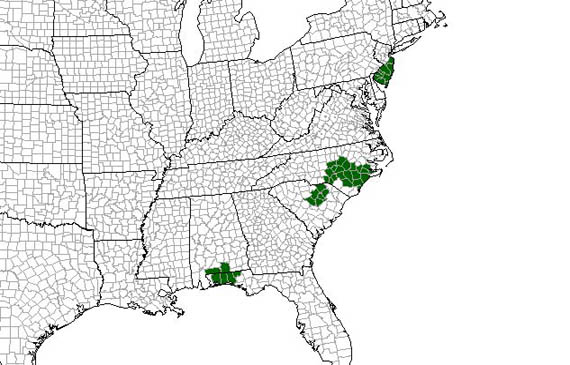In that article, the focus is on effort in the far-from-barren NJ Pinelands. The post online includes a video and follows Emile DeVito, an expert on endangered species in the 1.1-million-acre Pinelands National Reserve, who studies the rarest plants and animals.
Those species include the Pickering’s morning glory and the iconic Pine Barrens tree frog.
The Pickering's morning glory is not currently listed in NJ and so its rarity makes it the kind of species that needs attention (and will not get as much federal or state funding support) so that it is not overlooked and it moves to a threatened or endangered status.
 |
| Current limited range for the Pine Barrens treefrog |
The Pine Barrens treefrog is another kind of species case study. In 1979, iy was listed as an endangered species in New Jersey due to its restricted range, declining population, habitat loss, and pollution of breeding ponds. But conservation efforts moved the treefrog population to a point that it is currently considered stable.
New Jersey serves as a stronghold for this species throughout its entire range. In areas of suitable habitat, they may seem abundant. However, protection of this species is warranted, as quality habitat is limited to specialized Pine Barrens ecosystems patchily distributed throughout its range.
 |
| Flower of Stylisma pickeringii Pickering's Dawnflower or Pickering's Morning Glory, near Batsto, New Jersey. via Wikimedia |
As members of the New Jersey Conservation Foundation, New Jersey Audubon and the NJDEP track species, they can identify important habitat for that species.
For example, the docile pine snake can be tracked using implanted transmitters that allow us to discover winter dens and nesting sites.
 |
| Pine snake moving across sandy soil |
We have more than 80 species of wildlife from mammals to birds to insects in New Jersey that are considered endangered or threatened. (See list at www.state.nj.us) There are also dozens of plants that are in danger that probably get less attention than the "sexier" wildlifr.
Some habitats that need protectionare less than intuitive spaces. For example, Ryan Rebozo, director of conservation science at the Pinelands Preservation Alliance, says that the edges of roads in the Pinelands could replace some lost open areas, such as those lost by dousing fires that naturally create suitable habitat. But too often road departments are mowing these areas at inopportune times when some rare plants are flowering. He estimates that 11,000 acres of road edges could be suitable habitat for some of our rare plants, such as the the Pine Barrens gentian, which needs direct sunlight and flowers later in the fall when mowing is common.
As important as education and information, such as this post, can be, it alone isn’t going to save species. People, especially volunteers and the general public, need to take action.

No comments:
Post a Comment